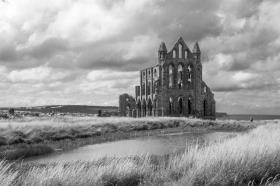
In order to capture stunning monochrome images of both landscape, portraits and still life it’s essential for the photographer to view the potential scene carefully for the best results take into account the light, shade, texture, tone and contrasts available.
When viewing a scene today with a digital camera we are accustomed to seeing things in various colours. Usually within your ‘menu’ settings it’s relatively easy to switch the camera picture style to capture the scene as a monochrome image. If saving as Jpeg its saved as a permanent monochrome image, alternatively if saving as a RAW file you will subsequently retain the colour, and by adjusting the image within software convert it to monochrome (this could also be used to convert a colour Jpeg saved file), either way, you’ll be able to see the scene captured immediately on the rear screen!
However, for many it has become more difficult to recognise when a monochrome image could infact work even better than colour. An image captured in monochrome allows us not to be distracted by colours (instead a variation of grey) and it permits us to carefully consider these various shades of grey, so the subject needs a stronger shape, contrast or texture to make it stand out. As a result of these shades of grey (or tones), what works as a colour image may fail in monochrome (or vice versa). Therefore, composition becomes ever-more important when photographing in monochrome.
When film was used to capture an image, the lens would often require a filter placed in front of the lens to ‘enhance’ certain tones within the image. With modern digital cameras this is no longer necessary as most software processing will undoubtedly have a variety of different coloured filter applications which can be applied to the digital image. Quite often this will include sliders to increase or reduce the effect.
On the basis we accept you’ve captured the scene with creative composition in mind, focussed appropriately etc, and you’ve also got the lighting and tonal range sorted, the final requirement really is the ‘texture’ evident within the image. Texture in an image can give the viewer an impression of what the subject ‘feels’ like; the bark of a tree, the fabric of clothes or furniture/curtains, the leather of a seat etc.
Most modern ink-jet printers are quite capable of producing good monochrome prints. Additional inks (if available) may be useful but you’ll need to check with your printer make for availability. Paper is also a serious consideration as with monochrome images matt paper gives a very different result to glossy or parchment paper, mainly due to the effect ‘black’ has on the paper.
I do offer feedback on photos so please try the ‘Photo Evaluation’ section to have your image(s) judged and receive constructive feedback 🙂